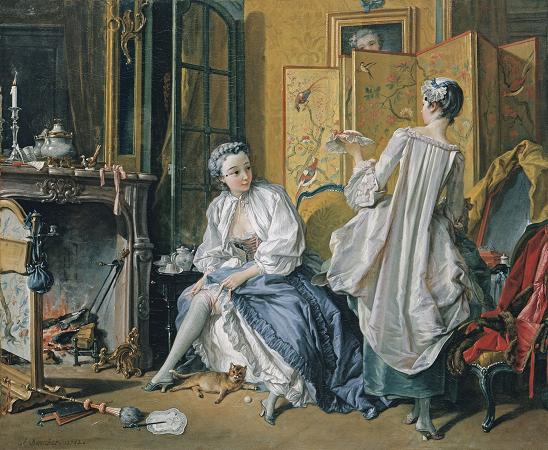Toilet. A toilet service is a set of objects for use at the dressing table. The term is usually reserved for large luxury sets from the 17th to 19th centuries, with toilet set used for later or simpler sets. Historically, services were made in metal, ceramics, and other materials, for both men and women, though male versions were generally much smaller. The rich had services in gold, silver, or silver-gilt. The contents vary, but typically include a mirror, one or more small ewers and basins, two candlesticks, and an assortment of bowls, boxes, caskets, and other containers. One or more brushes and a pin-cushion, often as a top to a box, are often included. The sets usually came with a custom-made travelling case, and some services were especially designed for travelling. The toilet service was the most important item of dressing plate, as opposed to table plate, and was often a gift upon marriage; sometimes augmented on the birth of children. It was normally the personal property of the wife. The morning levée was sometimes a semi-public occasion for great persons in the early modern period, and the toilet service might be seen by many people. The word toilet comes from the French toile meaning cloth, and toilette first came to mean the morning routine of washing, tidying hair, and shaving and making up as appropriate, from the cloth often spread on the dressing-table where this was done. This meaning spread into English as toilet in the 17th century; only later did toilet start to compete with lavatory as a euphemism. The Oxford English Dictionary records toilet in English first, from 1540, as a term for a cloth used to wrap clothes in, then from 1662 for a gold toilet service, and before 1700 for a range of related meanings, but not for a lavatory, which did not come into use until the 19th century. The contents of a service were variable but the classical grouping had as its largest piece the mirror, usually decorated at the top with some form of crest. In the 17th century these were rectangular, usually oblongs in portrait format, though the Louvre mirror and the Lennoxlove service use a landscape format. The frame normally had a wooden framework holding the glass, over which the metal was fitted. In the 18th century oval mirrors began to be used, and later the introduction of dressing tables with built-in mirrors was part of the decline from fashion of the toilet service. Depictions in art, such as the Zoffany of Queen Charlotte, wife of George III, usually show that the elaborate crest at the top of the mirror has disappeared beneath the lace covers spreading to the sides, which are probably tied round it. These were used to pull over the service on its table when it was not in use, or when husbands or other inconvenient visitors appeared in the dressing room. The service usually contained two fairly small candlesticks, allowing the face to be lit from below. There may also be hand-candles, chamber candles or chamber sticks, short, with a wide saucer-like base and a loop or handle. These were the last lights to be put out at night, and were carried in the hand. Candlestick makers were treated as a speciality within silversmithing, and the candlesticks may be made by different workshops from the other pieces, as may any snuffers, also regarded as a speciality. The service often contains one or a pair of ewer and basin sets for washing. There is normally a number of other vessels of various sizes and shapes, some covered and others not, which go by a great variety of names, and whose purpose was perhaps always rather undefined. A variety of brushes might be included, and sometimes a small bell. In the 18th century glass and porcelain items might be mixed in with the silver ones. Services also might contain food plates and cutlery for breakfast or snacks in the bedroom or dressing-room, or when travelling. One large type of bowl is connected with oatmeal, though it seems this might either be made into a facial, or eaten as porridge. Descriptions include items such as comb-boxes, glove-trays, soap-boxes, low tazze, salvers, ecuelles and others. The 48-piece German Schenk von Stauffenberg service contains several items for food and drink, including a teapot, and also items for writing, such as an inkstand. The male service was much simpler, typically consisting of a shaving-bowl, ewer and basin, a soap-box, toothbrush holder, perhaps a tongue-scraper and some boxes and bowls. These started later, in the 18th-century, when men began to shave themselves, or have a servant do it, rather than requiring a quasi-medical barber surgeon specialist. In Mundus Muliebris, a satire on fashionable ladies published in 1700, by Mary Evelyn, the daughter of John Evelyn, the toilet service was described.
more...













